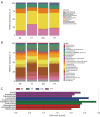A comparison of the microbiome composition in lower respiratory tract at different sites in early lung cancer patients
- PMID: 37425420
- PMCID: PMC10326795
- DOI: 10.21037/tlcr-23-231
A comparison of the microbiome composition in lower respiratory tract at different sites in early lung cancer patients
Abstract
Background: Lung microbiome dysbiosis has been associated with lung carcinogenesis. However, the differences in the microbiome composition at different lung sites of lung cancer patients remain little understood. Studying the whole lung microbiome in cancer patients could provide new insights for interpreting the complex interplay between the microbiome and lung cancer and finding new targets for more effective therapies and preventive measures.
Methods: A total of 16 patients with non-small cell lung cancer (NSCLC) were recruited for this study. Samples were obtained from four sites, including lung tumor tissues (TT), para-tumor tissues (PT), distal normal lung tissues (DN), and bronchial tissues (BT). The DNA was isolated from the tissues, and the V3-V4 regions were amplified. Sequencing libraries were generated and sequenced on an Illumina NovaSeq6000 platform.
Results: The richness and evenness of the microbiome were generally consistent among the TT, PT, DN, and BT groups in lung cancer patients. Principal coordinate analysis (PCoA) and nonmetric multidimensional scaling (NMDS) based on Bray-Curtis, weighted and unweighted UniFrac distance showed no distinct separation trend among the four groups. Proteobacteria, Firmicutes, Bacteroidota, and Desulfobacterota were the most common phyla in all four groups, while TT showed the highest abundance of Proteobacteria and the lowest abundance of Firmicutes. At the genus level, Rubellimicrobium and Fictibacillus were higher in the TT group. In the predicted functional analysis by PICRUSt, there were no specifically discrepant pathways among the four groups. In addition, an inverse relationship between body mass index (BMI) and alpha diversity was observed in this study.
Conclusions: A non-significant result was obtained from the microbiome diversity comparison between different tissues. However, we demonstrated that lung tumors were enriched with specific bacterial species, which might contribute to tumorigenesis. Moreover, we found an inverse relationship between BMI and alpha diversity in these tissues, providing a new clue for deciphering the mechanisms of lung carcinogenesis.
Keywords: 16S rRNA sequencing; Lung microbiome; microbiota dysbiosis; non-small cell lung cancer (NSCLC).
2023 Translational Lung Cancer Research. All rights reserved.
Conflict of interest statement
Conflicts of Interest: All authors have completed the ICMJE uniform disclosure form (available at https://tlcr.amegroups.com/article/view/10.21037/tlcr-23-231/coif). All authors report that this work was supported by the National Key R&D Program of China (No. 2020AAA0109500), National Natural Science Foundation of China (No. 82122053), the Beijing Municipal Science & Technology Commission (No. Z191100006619118), R&D Program of Beijing Municipal Education Commission (No. KJZD20191002302), CAMS Initiative for Innovative Medicine (Nos. 2021-1-I2M-012, and 2021-1-I2M-015), Key-Area Research and Development Program of Guangdong Province (No. 2021B0101420005), and Shenzhen Science and Technology Program (Nos. RCJC20221008092811025, and ZDSYS20220606101604009). The authors have no other conflicts of interest to declare.
Figures




Similar articles
-
Comparison of the lower genital tract microbiome composition in patients with benign gynecological disease.Front Glob Womens Health. 2025 Jan 21;6:1507907. doi: 10.3389/fgwh.2025.1507907. eCollection 2025. Front Glob Womens Health. 2025. PMID: 39911698 Free PMC article.
-
Dysbiosis of lower respiratory tract microbiome are associated with inflammation and microbial function variety.Respir Res. 2019 Dec 3;20(1):272. doi: 10.1186/s12931-019-1246-0. Respir Res. 2019. PMID: 31796027 Free PMC article.
-
Characteristics of the microbiome in lung adenocarcinoma tissue from patients in Kunming city of southwestern China.Environ Sci Pollut Res Int. 2023 Apr;30(17):49992-50001. doi: 10.1007/s11356-023-25528-1. Epub 2023 Feb 14. Environ Sci Pollut Res Int. 2023. PMID: 36787077
-
A Systematic Review and Meta-Analysis of 16S rRNA and Cancer Microbiome Atlas Datasets to Characterize Microbiota Signatures in Normal Breast, Mastitis, and Breast Cancer.Microorganisms. 2025 Feb 19;13(2):467. doi: 10.3390/microorganisms13020467. Microorganisms. 2025. PMID: 40005832 Free PMC article. Review.
-
Narrative review: respiratory tract microbiome and never smoking lung cancer.J Thorac Dis. 2023 Aug 31;15(8):4522-4529. doi: 10.21037/jtd-22-885. Epub 2023 Jul 26. J Thorac Dis. 2023. PMID: 37691669 Free PMC article. Review.
Cited by
-
Classification of NSCLC subtypes using lung microbiome from resected tissue based on machine learning methods.NPJ Syst Biol Appl. 2025 Jan 17;11(1):11. doi: 10.1038/s41540-025-00491-4. NPJ Syst Biol Appl. 2025. PMID: 39824879 Free PMC article.
-
Fecal Microbiota Strongly Correlates with Tissue Microbiota Composition in Colorectal Cancer but Not in Non-Small Cell Lung Cancer.Int J Mol Sci. 2025 Jan 16;26(2):717. doi: 10.3390/ijms26020717. Int J Mol Sci. 2025. PMID: 39859429 Free PMC article.
References
LinkOut - more resources
Full Text Sources
